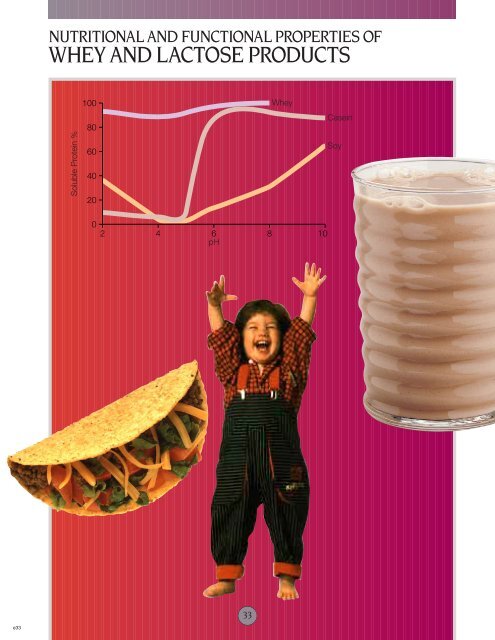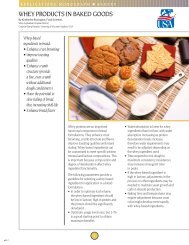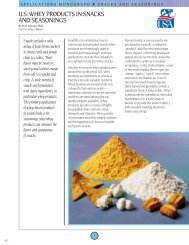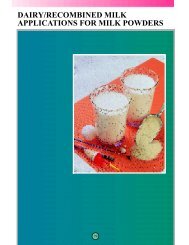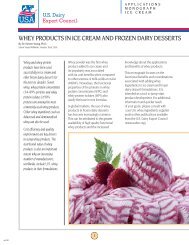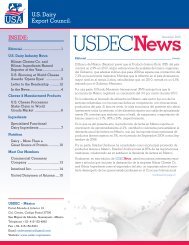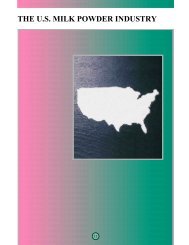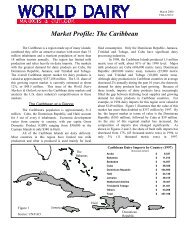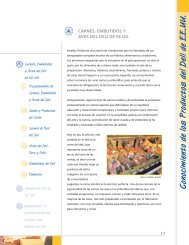nutritional and functional properties of whey and lactose
nutritional and functional properties of whey and lactose
nutritional and functional properties of whey and lactose
You also want an ePaper? Increase the reach of your titles
YUMPU automatically turns print PDFs into web optimized ePapers that Google loves.
NUTRITIONAL AND FUNCTIONAL PROPERTIES OF<br />
WHEY AND LACTOSE PRODUCTS<br />
Soluble Protein %<br />
100<br />
80<br />
60<br />
40<br />
20<br />
Whey<br />
Casein<br />
Soy<br />
0<br />
2<br />
4<br />
6<br />
pH<br />
8<br />
10<br />
e33<br />
33
NUTRITIONAL PROPERTIES OF WHEY PRODUCTS<br />
The composition <strong>of</strong><br />
<strong>whey</strong> products varies<br />
considerably, depending<br />
on milk source <strong>and</strong> the<br />
manufacturing process<br />
involved. In general, <strong>whey</strong><br />
is rich in proteins, <strong>lactose</strong>,<br />
minerals <strong>and</strong> vitamins.<br />
The proteins in milk <strong>and</strong><br />
<strong>whey</strong> are complete <strong>and</strong><br />
<strong>of</strong> exceptional quality.<br />
They contain, in varying<br />
amounts <strong>and</strong> in the<br />
right proportion, all the<br />
amino acids required by<br />
humans. They are also<br />
readily digestible <strong>and</strong><br />
completely bio-available.<br />
Clearly, <strong>whey</strong> proteins<br />
are among the most<br />
valuable component <strong>of</strong><br />
<strong>whey</strong>. In many cases,<br />
<strong>whey</strong> products are used<br />
for their <strong>nutritional</strong><br />
benefits as they are<br />
a very cost-efficient<br />
source <strong>of</strong> protein,<br />
carbohydrate<br />
<strong>and</strong> minerals<br />
such as<br />
calcium.<br />
PROTEINS<br />
The proteins in <strong>whey</strong> are easily digested<br />
<strong>and</strong> contain all the essential amino acids<br />
in the proper proportions, <strong>and</strong> they rate<br />
as an excellent <strong>nutritional</strong> source.<br />
Using the Protein Digestibility-Corrected<br />
Amino Acid Scoring (PDCAAS) method,<br />
<strong>whey</strong> protein rates a value <strong>of</strong> 1.0 because<br />
it is highly digestible <strong>and</strong> it meets or<br />
exceeds the recommended amount<br />
<strong>of</strong> each essential amino acid.<br />
Using another method to measure<br />
protein quality—the Protein Efficiency<br />
Ratio (PER) value—<strong>whey</strong> also ranks high<br />
on the scale. The higher the PER value,<br />
the better the protein. Casein, the reference<br />
protein, has a PER value <strong>of</strong> 2.5.<br />
Proteins with a PER greater than 2.5<br />
are considered to be quality proteins.<br />
Whey protein, with a PER greater than<br />
3.0, is considered to be a <strong>nutritional</strong>ly<br />
excellent protein.<br />
Figure 3<br />
Essential amino acid pr<strong>of</strong>ile <strong>of</strong> sweet <strong>whey</strong> proteins<br />
<strong>and</strong> <strong>nutritional</strong> requirements <strong>of</strong> selected groups (FAO/WHO)<br />
Essential Amino Acids<br />
Valine<br />
Tryptophan<br />
Threonine<br />
Phenylalanine.+Tyrosine<br />
Methionine.+Cystine<br />
Lysine<br />
Leucine<br />
5<br />
9<br />
11<br />
13<br />
17<br />
16<br />
19<br />
19<br />
22<br />
24<br />
35<br />
34<br />
41<br />
Virtually every amino acid present in<br />
sweet-type <strong>whey</strong> exceeds Food <strong>and</strong><br />
Agriculture Organization/World Health<br />
Organization (FAO/WHO) <strong>nutritional</strong><br />
intake recommendations, both for<br />
children aged 2 to 5 <strong>and</strong> for adults<br />
(see Figure 3). In many cases, for adults,<br />
<strong>whey</strong> proteins <strong>of</strong>fer more than double<br />
the minimum FAO/WHO st<strong>and</strong>ards.<br />
59<br />
58<br />
62<br />
63<br />
66<br />
68<br />
88<br />
Whey Powder<br />
Child, 2-5 years<br />
Adult<br />
103<br />
Isoleucine<br />
13<br />
28<br />
59<br />
Histidine<br />
20<br />
19<br />
16<br />
0<br />
20<br />
40<br />
60<br />
mg/g Crude Protein<br />
80<br />
100<br />
120<br />
Source: Glass, L. <strong>and</strong> T.I. Hedrick. FAO/WHO. 1976<br />
34<br />
e34
Whey proteins compare favorably to<br />
many common proteins that have a PER<br />
<strong>of</strong> less than 2.5, including soya, peanuts,<br />
corn <strong>and</strong> wheat gluten (see Figure 4).<br />
These proteins have limited concentrations<br />
<strong>of</strong> certain essential amino acids.<br />
Because <strong>of</strong> <strong>whey</strong> protein’s balanced<br />
amino acid pr<strong>of</strong>ile, <strong>whey</strong> products<br />
are excellent ingredients for protein<br />
fortification. By fortifying certain vegetable<br />
proteins with <strong>whey</strong> proteins,<br />
scientists have achieved PER values<br />
significantly greater than 2.5 <strong>and</strong> greater<br />
than the average <strong>of</strong> the PER values for<br />
the two proteins. In each blend, <strong>whey</strong><br />
protein contributed no more than<br />
50% <strong>of</strong> the total protein.<br />
VITAMINS<br />
The water soluble vitamins in milk remain<br />
in the serum <strong>and</strong> are collected with the <strong>whey</strong>.<br />
The concentration <strong>of</strong> vitamin C is reduced<br />
during processing, <strong>and</strong> <strong>whey</strong> is not considered<br />
a significant source <strong>of</strong> vitamin C. The concentration<br />
<strong>of</strong> other water soluble vitamins in sweet<br />
<strong>whey</strong> powder is presented in Table 4.<br />
Vitamins are large molecules <strong>and</strong><br />
they are concentrated by ultrafiltration.<br />
Whey products will naturally fortify the<br />
thiamin, rib<strong>of</strong>lavin, pantothenic acid,<br />
vitamin B 6 <strong>and</strong> vitamin B 12 content <strong>of</strong><br />
foods. Suppliers can provide specific<br />
information on the vitamin contents<br />
<strong>of</strong> their <strong>whey</strong> products.<br />
Vitamin A is the most abundant fat<br />
soluble vitamin in milk. Vitamins A, D, E,<br />
<strong>and</strong> K are separated with the milk fat that<br />
is entrapped in the curd <strong>and</strong> separated<br />
with the <strong>whey</strong> cream.<br />
Figure 4<br />
Protein Efficiency Ratios (PER) <strong>of</strong><br />
Various Animal <strong>and</strong> Vegetable Proteins<br />
Table 4<br />
Water Soluble Vitamin Content <strong>of</strong><br />
Sweet Whey Powder<br />
Casein<br />
Whey Protein<br />
Sodium Caseinate<br />
Hen Egg<br />
Peanut<br />
Soya<br />
Corn<br />
1.8<br />
2.2<br />
2.2<br />
2.5<br />
2.6<br />
3.2<br />
3.9<br />
WHO Recommended<br />
Daily Intake*<br />
Sweet Whey<br />
Child Adult Powder<br />
Vitamin 1–3 years male Content/100g**<br />
Thiamin (B 1 ) 0.5mg 1.2mg 0.5mg<br />
Rib<strong>of</strong>lavin (B 2 ) 0.8mg 1.8mg 2.2mg<br />
Niacin (PP) 9.0mg 19.8mg 1.3mg<br />
Pantothenic Acid<br />
5.6mg<br />
Vitamin B 6<br />
2.4µg<br />
Folic Acid 100.0µg 200.0µg 12.0µg<br />
Vitamin B 12 0.9µg 2.0µg 2.4µg<br />
Wheat Gluten<br />
0.8<br />
*World Health Organization. 1974.<br />
**Potosi <strong>and</strong> Orr. 1976.<br />
0<br />
1<br />
2<br />
PER<br />
3<br />
4<br />
Source: Anon. 1972.<br />
e35<br />
35
‘‘In the future, one <strong>of</strong><br />
the most dynamic uses<br />
<strong>of</strong> <strong>whey</strong> products will continue<br />
to be as <strong>nutritional</strong><br />
ingredients. Whey proteins<br />
are among the highest<br />
quality proteins available<br />
for human nutrition<br />
<strong>and</strong> they are available in<br />
ingredients <strong>and</strong> packaging<br />
that can be shipped <strong>and</strong><br />
used virtually anywhere.’’<br />
David L. Stiefer,<br />
Vice President Business Development,<br />
Milk Marketing Inc.,<br />
Strongsville, Ohio<br />
MINERALS<br />
Data in Table 5 indicates that<br />
<strong>whey</strong> powder is a good source <strong>of</strong><br />
certain essential minerals.<br />
As the pH <strong>of</strong> milk decreases during<br />
acid cheese production, more <strong>of</strong> the<br />
salts dissociate. This results in higher<br />
concentrations <strong>of</strong> soluble calcium,<br />
magnesium, zinc <strong>and</strong> phosphorous<br />
in acid <strong>whey</strong>.<br />
The concentration <strong>of</strong> calcium <strong>and</strong><br />
other minerals may be altered during<br />
<strong>whey</strong> processing. Mineral concentrations<br />
are reduced by electrodialysis <strong>and</strong> ultrafiltration,<br />
<strong>and</strong> adjusted to achieve unique<br />
<strong>functional</strong> <strong>properties</strong>. Information for<br />
mineral content <strong>of</strong> specific products<br />
should be obtained from the supplier<br />
<strong>of</strong> the product.<br />
LACTOSE<br />
Lactose is a disaccharide that is<br />
hydrolyzed by the enzyme beta-galactosidase<br />
into glucose <strong>and</strong> ga<strong>lactose</strong> molecules.<br />
The slow hydrolysis <strong>of</strong> <strong>lactose</strong> by the<br />
body during digestion generates a<br />
prolonged energy supply. Lactose<br />
stimulates the growth <strong>of</strong> acid forming<br />
lactobacilli in the intestinal tract.<br />
Recent <strong>nutritional</strong> studies suggest that<br />
lactobacilli help fight intestinal disorders<br />
<strong>and</strong> that <strong>lactose</strong> could be used in dietary<br />
therapy for ailing infants.<br />
Numerous studies have demonstrated<br />
that <strong>lactose</strong> increases calcium absorption<br />
<strong>and</strong> retention. It may also improve the<br />
absorption <strong>of</strong> magnesium <strong>and</strong> zinc.<br />
In animal studies, <strong>lactose</strong> extended<br />
life expectancy <strong>and</strong> reduced the<br />
accumulation <strong>of</strong> body fat.<br />
Table 5<br />
Essential Minerals Content <strong>of</strong><br />
Acid <strong>and</strong> Sweet Whey Powders<br />
WHO Recommended Acid Whey Sweet Whey<br />
Daily Intake* Powder Powder<br />
Mineral Adult male Content/100g** Content/100g**<br />
Calcium 500mg 2,054mg 796mg<br />
Zinc 22mg 6.31mg 1.97mg<br />
Magnesium 300mg 199mg 176mg<br />
Phosphorus 1,348mg 932mg<br />
*World Health Organization. 1974.<br />
**Potosi <strong>and</strong> Orr. 1976.<br />
36<br />
e36
WHEY PROTEINS<br />
They possess solubility; create<br />
viscosity through water binding;<br />
form gels; emulsify; bind fat; facilitate<br />
whipping, foaming <strong>and</strong> aeration; enhance<br />
color, flavor <strong>and</strong> texture; <strong>and</strong> bring with<br />
them numerous <strong>nutritional</strong> benefits as<br />
noted in the previous section.<br />
Milk proteins are <strong>of</strong>ten divided into<br />
two broad classes: caseins <strong>and</strong> <strong>whey</strong><br />
proteins. Approximately 80% <strong>of</strong> the<br />
proteins in milk are caseins, <strong>and</strong> these<br />
are coagulated <strong>and</strong> separated as the<br />
cheese curd (see Table 6).<br />
The <strong>whey</strong> proteins (also called<br />
milk serum proteins) are the proteins<br />
that remain soluble when caseins<br />
are coagulated by either enzyme<br />
or acid. The <strong>whey</strong> proteins include<br />
beta-lactoglobulin, alpha-lactalbumin,<br />
blood serum albumins, immunoglobulins<br />
<strong>and</strong> protease-peptones fractions. Part<br />
<strong>of</strong> the protease-peptones have been<br />
identified as proteolytic degradation<br />
products <strong>of</strong> beta-casein.<br />
The heat-sensitive <strong>whey</strong> proteins (betalactoglobulin,<br />
alpha-lactalbumin, blood<br />
serum albumins <strong>and</strong> immunoglobulins)<br />
differ in molecular weights <strong>and</strong> <strong>properties</strong><br />
such as isoelectric points (see Table 7).<br />
The <strong>functional</strong> <strong>properties</strong> <strong>of</strong> <strong>whey</strong><br />
proteins are influenced by a number<br />
<strong>of</strong> compositional <strong>and</strong> processing<br />
variables including:<br />
■ pH 12<br />
■ Calcium ion concentration<br />
■ Salt concentration<br />
■ Previous heat treatments<br />
■ Residual lipid content<br />
■ Protein concentration<br />
The term pH st<strong>and</strong>s for the potential<br />
hydrogen ion concentration in a solution.<br />
At pH 7.0, the number <strong>of</strong> hydrogen <strong>and</strong><br />
hydroxyl ions in solution are equal to<br />
each other, <strong>and</strong> the solution is neutral.<br />
At pH values below 7.0, the number <strong>of</strong><br />
hydrogen ions exceeds the hydroxyl ions,<br />
<strong>and</strong> the solution is acidic. At pH values<br />
above 7.0, the number <strong>of</strong> hydroxyl ions<br />
exceeds the hydrogen ions, <strong>and</strong> the<br />
solution is alkaline.<br />
Proteins make<br />
up approximately<br />
0.78% <strong>of</strong> fluid <strong>whey</strong><br />
<strong>and</strong> 11%–13% <strong>of</strong> solids<br />
in dried <strong>whey</strong>. Whey<br />
proteins are important<br />
components <strong>of</strong> <strong>whey</strong><br />
because they possess<br />
a host <strong>of</strong> <strong>functional</strong><br />
<strong>properties</strong> that make<br />
them invaluable<br />
food ingredients.<br />
12The pH values increase logarithmically.<br />
A pH 4.0 solution is 10 times as acid<br />
as a pH 5.0 solution, <strong>and</strong> 100 times<br />
as acid as a pH 6.0 solution. As the<br />
concentration <strong>of</strong> hydrogen ions in<br />
solution increases, the negative charge<br />
on the proteins is neutralized. At the<br />
pH identified as the isoelectric point<br />
for a protein, the charge on the protein<br />
becomes neutral, <strong>and</strong> the proteins will<br />
not migrate in an electric field. At this<br />
pH, the physical <strong>properties</strong> <strong>of</strong> proteins<br />
(solubility, conductivity, stability <strong>and</strong><br />
degree <strong>of</strong> hydration) are at a minimum.<br />
Table 6<br />
Concentration <strong>of</strong> Major Milk Proteins<br />
Approximate<br />
% <strong>of</strong> Total<br />
Protein Concentration (g/l) Protein<br />
Caseins 24–28 80<br />
• alpha-casein 15–19 42<br />
• beta-casein 9–11 25<br />
• kappa-casein 3–4 9<br />
• gamma-casein 1–2 4<br />
Whey proteins 5–7 20<br />
• beta-lactoglobulin 2–4 9<br />
• alpha-lactalbumin 1–1.5 4<br />
• protease-peptones 0.6–1.8 4<br />
• blood proteins 1.4–1.6 2<br />
serum albumin 0.1–0.4 1<br />
immunoglobulins 0.6–1.0 2<br />
100<br />
Table 7<br />
Characteristics <strong>of</strong> Heat-Sensitive Proteins<br />
in Cheese Whey<br />
Approximate<br />
% <strong>of</strong> Whey Molecular Isoelectric<br />
Protein Proteins Weight Point<br />
• beta-lactoglobulin 48 18,400–36,800 5.2<br />
• alpha-lactalbumin 19 14,200 5.1<br />
• Protease-peptones* 20 4,000–80,000 5.1–6.0<br />
• Blood proteins: 13 69,000 4.8<br />
serum albumin 5 69,000 4.8<br />
immunoglobulins 8 160,000 5.5–6.8<br />
100<br />
*Degradation products <strong>of</strong> various milk proteins including beta-caseins.<br />
Source: de Wit, 1981; Harper, 1984.<br />
Source: Fennema, 1965.<br />
e37<br />
37
FUNCTIONAL PROPERTIES OF WHEY PRODUCTS<br />
While the on-going<br />
research into <strong>whey</strong><br />
proteins, utilization <strong>and</strong><br />
<strong>functional</strong>ity continues,<br />
<strong>whey</strong> ingredients already<br />
<strong>of</strong>fer numerous <strong>functional</strong><br />
benefits to food formulators.<br />
They possess solubility,<br />
create viscosity through<br />
water binding, form gels,<br />
emulsify, bind fat, facilitate<br />
whipping, foaming <strong>and</strong><br />
aeration, enhance color,<br />
flavor <strong>and</strong> texture, <strong>and</strong><br />
bring with them numerous<br />
<strong>nutritional</strong> advantages.<br />
SOLUBILITY<br />
Whey protein is highly soluble, especially<br />
when compared to sodium caseinate <strong>and</strong><br />
soy protein (see Figure 5). Solubility is<br />
an important <strong>functional</strong> property in fluid<br />
<strong>and</strong> semi-fluid products.<br />
In ready-to-drink beverages, solubility<br />
prevents protein flocculation or sedimentation,<br />
which improves both product<br />
appearance <strong>and</strong> texture.<br />
In processed soups <strong>and</strong> sauces,<br />
curdling, sedimentation <strong>and</strong> separation<br />
associated with insoluble proteins are<br />
highly undesirable.<br />
In chopped meats, salad dressings,<br />
dairy <strong>and</strong> bakery products, proteins<br />
provide emulsification, gelation <strong>and</strong><br />
water binding. In most processed foods,<br />
processing is simplified <strong>and</strong> product consistency<br />
is improved by using ingredients<br />
that are soluble <strong>and</strong> easily dispersed.<br />
The effect <strong>of</strong> heating on solubility is<br />
a second concern <strong>of</strong> food formulators.<br />
Many foods are heat processed for<br />
preservation purposes. Cream soups<br />
<strong>and</strong> sauces may be canned <strong>and</strong> commercially<br />
sterilized for shelf stability,<br />
<strong>and</strong> these will be further heated by the<br />
consumer. Denaturation <strong>and</strong> loss <strong>of</strong><br />
solubility can occur when protein solutions<br />
with a pH <strong>of</strong> 3.5–5.5 are heated<br />
to 60°C <strong>and</strong> higher. Loss <strong>of</strong> solubility<br />
is enhanced by calcium ions in<br />
the solution.<br />
In high-acid systems with pH less than<br />
3.5, such as fruit-flavored beverages<br />
<strong>and</strong> salad dressings, undenatured <strong>whey</strong><br />
proteins remain soluble when heated<br />
to temperatures <strong>of</strong> 90°C or higher for<br />
5 minutes. Likewise, proteins in dilute<br />
solutions above pH 6.5 remain soluble<br />
when heated at a temperature <strong>of</strong><br />
80°C for10 minutes or longer.<br />
In milk, as well as chocolate-, vanillaor<br />
c<strong>of</strong>fee-flavored beverages, a neutral<br />
pH provides the best flavor characteristic.<br />
Caseins <strong>and</strong> <strong>whey</strong> proteins are soluble in<br />
these food systems, <strong>and</strong> protein choice<br />
is based on other <strong>properties</strong>, including<br />
nutrition, flavor <strong>and</strong> cost. In fruit- or<br />
cola-flavored beverages <strong>and</strong> fruit juice<br />
blends, an acidic pH enhances flavor.<br />
While <strong>whey</strong> proteins are soluble in acidic<br />
solutions, soy protein <strong>and</strong> caseins are<br />
likely to precipitate.<br />
Figure 5<br />
Solubility <strong>of</strong> proteins as affected by pH<br />
Soluble Protein %<br />
100<br />
80<br />
60<br />
40<br />
20<br />
Whey<br />
Casein<br />
Soy<br />
0<br />
2<br />
4<br />
6<br />
pH<br />
8<br />
10<br />
38<br />
e38
WATER BINDING<br />
AND VISCOSITY<br />
Water binding <strong>and</strong> viscosity are related<br />
<strong>functional</strong> <strong>properties</strong>. Products that bind<br />
large quantities <strong>of</strong> water, such as starches<br />
<strong>and</strong> gums, create viscosity. When <strong>whey</strong> proteins<br />
are heated, the bonds that are responsible<br />
for their globular structure break down.<br />
As the protein molecule unfolds, additional<br />
water binding sites are created, which<br />
increases the viscosity <strong>of</strong> the solution.<br />
In <strong>nutritional</strong> beverage products, low<br />
viscosity allows product developers to<br />
increase protein levels in a drink without<br />
damaging visual appeal, taste or texture.<br />
In addition, <strong>whey</strong> can add turbidity<br />
or opacity.<br />
In products such as puddings <strong>and</strong><br />
yogurts, water binding <strong>properties</strong> help<br />
produce a more viscous texture <strong>and</strong><br />
control separation. Yogurts fortified<br />
with WPC synerese (lose water) significantly<br />
less than yogurts fortified<br />
with nonfat dried milk.<br />
In chopped meats <strong>and</strong> bakery products,<br />
water binding contributes to the texture<br />
<strong>of</strong> the meat emulsion <strong>and</strong> bakery dough.<br />
In these products, water binding reduces<br />
cooking <strong>and</strong> baking losses, improves<br />
yields <strong>and</strong> contributes to the moistness<br />
<strong>of</strong> the final product. Increased moisture<br />
content in dairy foods helps enhance<br />
the sensory pr<strong>of</strong>ile by increasing<br />
flavor release.<br />
Water binding <strong>properties</strong> contribute to<br />
the formulation <strong>of</strong> reduced-fat products<br />
by adding fat-like attributes such as<br />
lubricity <strong>and</strong> mouthfeel. In addition,<br />
certain <strong>whey</strong> products add opacity to<br />
reduced-fat dairy formulations.<br />
GELLING<br />
Under specific conditions, <strong>whey</strong> proteins<br />
form non-reversible gels. Gel characteristics<br />
depend upon the protein concentration, the<br />
pH <strong>of</strong> the solution, calcium ion concentration<br />
<strong>and</strong> sodium ion concentration.<br />
For example, gels formed in solutions<br />
with 3%–5% protein concentrations<br />
<strong>and</strong> at a temperature <strong>of</strong> 55°–70°C tend<br />
to be more translucent <strong>and</strong> s<strong>of</strong>ter. More<br />
opaque gels are formed when higher<br />
protein concentrations (10%) are heated<br />
to higher (90°–100°C) temperatures.<br />
In acidic conditions, gels tend to be<br />
opaque, wet <strong>and</strong> weak. In neutral <strong>and</strong><br />
higher pH solutions, gels tend to be<br />
more translucent <strong>and</strong> elastic.<br />
Microparticles <strong>of</strong> <strong>whey</strong> protein gels<br />
maintain moistness in baked goods<br />
<strong>and</strong> meats; add opacity to beverages<br />
<strong>and</strong> dairy products; <strong>and</strong> improve texture<br />
<strong>and</strong> mouthfeel in reduced-fat products,<br />
bakery products, processed cheese,<br />
yogurt, puddings <strong>and</strong> custards, <strong>and</strong><br />
chopped meats <strong>and</strong> seafood.<br />
EMULSIFYING<br />
Whey proteins have both hydrophilic<br />
(water attracting) <strong>and</strong> hydrophobic<br />
(water repelling) groups.<br />
Whey protein functions as well as<br />
traditional emulsifiers (such as egg yolk<br />
powder) in mayonnaise type dressings,<br />
<strong>and</strong> they are lower in cholesterol. The<br />
stability <strong>of</strong> <strong>whey</strong> protein emulsions can<br />
be further enhanced by adding gums or<br />
heating the system to create a protein<br />
gel. The emulsification <strong>properties</strong> <strong>of</strong><br />
<strong>whey</strong> proteins can be an advantage in<br />
most processed food products, including<br />
margarine, sauces, chopped meats <strong>and</strong><br />
seafood, ice cream mixes, bread dough<br />
<strong>and</strong> cake batters.<br />
e39<br />
39
FAT BINDING<br />
Fat binding <strong>properties</strong> <strong>of</strong> <strong>whey</strong> products go<br />
h<strong>and</strong>-in-h<strong>and</strong> with its emulsifying <strong>properties</strong>,<br />
a result <strong>of</strong> the presence <strong>of</strong> both hydrophilic <strong>and</strong><br />
hydrophobic groups.<br />
The hydrophobic groups are also<br />
lipophilic (lipid attracting) in nature.<br />
WPC, for example, is added to chopped<br />
meat products for its fat binding <strong>and</strong><br />
retention <strong>properties</strong>.<br />
WHIPPING, FOAMING<br />
AND AERATION<br />
Table 8<br />
Flavor Descriptions Applied to Products Generated<br />
by the Thermal Degradation <strong>of</strong> Amino Acids<br />
Probable amino acid precursors<br />
Phenylalanine, Glycine<br />
Leucine<br />
Glycine, Cystine<br />
Alanine<br />
alpha-Aminobutyric acid<br />
Phenylalanine<br />
Proline<br />
Ornithine<br />
Glutamine, Lysine<br />
Arginine<br />
Methionine<br />
Leucine, Arginine, Histidine<br />
The formation <strong>of</strong> a foam is similar to the<br />
formation <strong>of</strong> an emulsion, only in this case,<br />
<strong>whey</strong> proteins function to stabilize the<br />
interface around the air micelle.<br />
The speed <strong>of</strong> air incorporation <strong>and</strong> the<br />
stability <strong>of</strong> the foam is dependent on a<br />
number <strong>of</strong> parameters, including total<br />
solids, protein <strong>and</strong> carbohydrate concentration,<br />
pH, the concentration <strong>of</strong> calcium<br />
<strong>and</strong> other ions, <strong>and</strong> whipping method.<br />
Typical flavor description<br />
<strong>of</strong> thermal products<br />
caramel like<br />
bread like, toasted<br />
smoky, burnt<br />
nutty<br />
walnut<br />
roast nuts, almonds<br />
bakery, cracker<br />
cracker like<br />
buttery<br />
popcorn<br />
broth, beany<br />
bread like<br />
Whey proteins can be used to<br />
partially replace or extend eggs in<br />
bakery products, <strong>of</strong>fering economic<br />
<strong>and</strong> microbiological advantages as<br />
well as a more consumer-friendly<br />
label. Good whipping <strong>and</strong> foaming<br />
<strong>properties</strong> are crucial to the production<br />
<strong>of</strong> whipped toppings, icings, ice cream<br />
<strong>and</strong> frozen yogurt.<br />
FLAVOR<br />
In their pure form, <strong>whey</strong> proteins are very<br />
bl<strong>and</strong> in flavor. However, depending on the<br />
application, <strong>whey</strong> can either serve to bring out<br />
already-present flavors or add flavor <strong>of</strong> its own.<br />
For example, when <strong>whey</strong> proteins are<br />
heated, volatile sulfides are produced.<br />
Free amino acids are also converted to<br />
flavorful compounds by the heat <strong>and</strong><br />
chemical interaction with other compounds<br />
(see Table 8). Whey proteins<br />
provide a range <strong>of</strong> flavors as well as<br />
aroma to bakery products.<br />
In other food categories, such as<br />
beverages <strong>and</strong> confections, <strong>whey</strong>’s bl<strong>and</strong>,<br />
slightly sweet flavor allows other fruit<br />
<strong>and</strong> chocolate flavors to come through.<br />
In soups <strong>and</strong> sauces, spices <strong>and</strong> herb<br />
flavors are accentuated.<br />
Whey minerals also enhance dairy<br />
<strong>and</strong> meat flavors. In applications where<br />
the mineral flavor is a disadvantage,<br />
demineralized <strong>whey</strong> or WPC with<br />
lower mineral content are available<br />
from U.S. suppliers.<br />
Source: Kinsella, J. E. 1970.<br />
40<br />
e40
FUNCTIONAL PROPERTIES OF LACTOSE PRODUCTS<br />
FLAVOR AND COLOR<br />
ABSORPTION AND RETENTION<br />
Lactose is several times more effective<br />
than most sugars in attracting <strong>and</strong> holding<br />
volatile aromas <strong>and</strong> flavors. It shows equal<br />
affinity for aldehydes, ketones <strong>and</strong> esters—<br />
the volatile flavor compounds that are<br />
important in many foods.<br />
In addition to absorbing flavors, <strong>lactose</strong><br />
enhances <strong>and</strong> renders many flavors more<br />
distinguishable to the taste. Likewise,<br />
<strong>lactose</strong> has a strong tendency to absorb<br />
synthetic <strong>and</strong> natural colors. In tomato<br />
sauce, for example, <strong>lactose</strong> can reduce<br />
the acid taste, enhance the tomato flavor<br />
<strong>and</strong> preserve the red color.<br />
BROWNING<br />
Lactose is a reducing sugar, <strong>and</strong> it will<br />
react with amines to form typical Maillard<br />
(non-enzymatic browning) compounds.<br />
It also caramelizes, although the temperature<br />
at which it caramelizes is higher than<br />
most sugars.<br />
The crust color <strong>of</strong> breads <strong>and</strong> rolls is<br />
enhanced by high-<strong>lactose</strong> <strong>whey</strong> products,<br />
<strong>and</strong> is more golden-brown than the<br />
crust color produced by dextrose.<br />
HYGROSCOPICITY<br />
The alpha-<strong>lactose</strong> monohydrate form <strong>of</strong><br />
<strong>lactose</strong> is very stable. It is non-hygroscopic<br />
<strong>and</strong> will remain free flowing in high<br />
temperatures <strong>and</strong> high relative humidity.<br />
This is one reason for using <strong>lactose</strong> as a carrier<br />
for other ingredients such as high-intensity<br />
sweeteners, flavors, <strong>and</strong> seasonings.<br />
By controlling the drying <strong>of</strong> high-<strong>lactose</strong><br />
<strong>whey</strong> products, the percentage <strong>of</strong> <strong>lactose</strong><br />
in the alpha-monohydrate form can be<br />
maximized. These <strong>whey</strong> products are<br />
also non-hygroscopic <strong>and</strong> are excellent<br />
bulking <strong>and</strong> flow agents in dry mixes.<br />
The crystals also facilitate dispersion<br />
in water.<br />
Supersaturated solutions <strong>of</strong> <strong>lactose</strong><br />
may form a solid mass termed ‘‘<strong>lactose</strong><br />
glass’’ or ‘‘amorphous <strong>lactose</strong>.’’ Lactose<br />
in this form is very hygroscopic. This<br />
affinity for moisture is an asset in preserving<br />
the moistness <strong>and</strong> tenderness<br />
in baked goods <strong>and</strong> confections. Lactose<br />
in solutions causes a decrease in the<br />
vapor pressure <strong>of</strong> the moisture, retards<br />
moisture loss <strong>and</strong> prolongs freshness.<br />
Lactose provides<br />
numerous <strong>functional</strong><br />
benefits to food formulators.<br />
It possesses solubility;<br />
acts as a bulking or<br />
flow agent in dry mixes;<br />
contributes solids <strong>and</strong> a<br />
low level <strong>of</strong> sweetness;<br />
enhances color, flavor<br />
<strong>and</strong> texture; facilitates<br />
browning; <strong>and</strong> can be<br />
directly compressed<br />
into tablets.<br />
In both caramel-type confections<br />
<strong>and</strong> bakery products, the color <strong>and</strong><br />
flavor development from the <strong>lactose</strong><br />
<strong>and</strong> amine-<strong>lactose</strong> interactions is desired.<br />
e41<br />
41
SWEETNESS<br />
A10% sucrose solution is equal to a<br />
20% <strong>lactose</strong> solution in perceived sweetness.<br />
At common concentrations in foods,<br />
<strong>lactose</strong> is one-fifth to one-third as sweet<br />
as sucrose. This is an advantage because<br />
excess sweetness does not limit the<br />
use <strong>of</strong> <strong>lactose</strong>.<br />
SOLUBILITY<br />
Lactose is soluble, but less so than the<br />
other common sugars such as sucrose,<br />
fructose <strong>and</strong> dextrose.<br />
The solubility <strong>of</strong> <strong>lactose</strong> is limited when<br />
adding either <strong>lactose</strong> or dairy ingredients<br />
with high concentrations <strong>of</strong> <strong>lactose</strong> to<br />
foods. To avoid crystal formation <strong>and</strong><br />
s<strong>and</strong>y texture, WPCs are added for<br />
the maximum concentration <strong>of</strong> <strong>whey</strong><br />
in frozen desserts. Reduced-<strong>lactose</strong><br />
<strong>whey</strong> is used to maximize total <strong>whey</strong> in<br />
processed cheese foods. In confections,<br />
addition <strong>of</strong> corn syrup <strong>and</strong> fat can aid<br />
in controlling crystallization. In other<br />
products, such as sweetened condensed<br />
milk, crystallization is controlled by<br />
adding <strong>lactose</strong> seed crystals to the<br />
saturated solution. The crystals that<br />
form are very small <strong>and</strong> impalpable.<br />
When the size <strong>of</strong> the <strong>lactose</strong> crystals<br />
is controlled, crystallization can be an<br />
advantage in creating a desired texture<br />
in some confection products. It can also<br />
aid in controlling the hygroscopicity<br />
<strong>of</strong> a product.<br />
FERMENTATION SUBSTRATE<br />
Lactose is converted to lactic acid by<br />
lactic cultures.<br />
This fermentation process is important<br />
to both flavor <strong>and</strong> texture. Some cultures<br />
also can convert <strong>lactose</strong> to propionic<br />
acid. Dependent upon the concentration,<br />
the propionic acid produced can control<br />
mold growth. Lactose is not fermented<br />
by bakers yeast. In yeast-leavened<br />
bakery products, the <strong>lactose</strong> remains<br />
available for crust color development,<br />
emulsification <strong>of</strong> shortening <strong>and</strong><br />
water retention.<br />
TABLETTING EXCIPIENT<br />
Lactose can be directly compressed by<br />
pressure into tablets without wet granulation.<br />
When used in c<strong>and</strong>y tablets, the other<br />
<strong>properties</strong>, such as color <strong>and</strong> flavor<br />
absorption <strong>and</strong> retention, <strong>and</strong> rapid<br />
solubility are an advantage. Lactose<br />
products have been developed with<br />
exceptional flow <strong>properties</strong> for high<br />
speed tablet machines. Because <strong>of</strong><br />
this <strong>functional</strong>ity, <strong>lactose</strong> is also used<br />
in pharmaceutical applications.<br />
42<br />
e42


